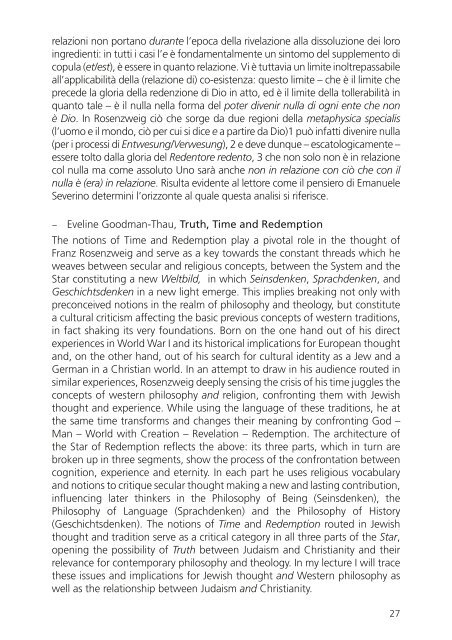Franz Rosenzweig
VZ2hG1
VZ2hG1
You also want an ePaper? Increase the reach of your titles
YUMPU automatically turns print PDFs into web optimized ePapers that Google loves.
elazioni non portano durante l’epoca della rivelazione alla dissoluzione dei loro<br />
ingredienti: in tutti i casi l’e è fondamentalmente un sintomo del supplemento di<br />
copula (et/est), è essere in quanto relazione. Vi è tuttavia un limite inoltrepassabile<br />
all’applicabilità della (relazione di) co-esistenza: questo limite – che è il limite che<br />
precede la gloria della redenzione di Dio in atto, ed è il limite della tollerabilità in<br />
quanto tale – è il nulla nella forma del poter divenir nulla di ogni ente che non<br />
è Dio. In <strong>Rosenzweig</strong> ciò che sorge da due regioni della metaphysica specialis<br />
(l’uomo e il mondo, ciò per cui si dice e a partire da Dio)1 può infatti divenire nulla<br />
(per i processi di Entwesung/Verwesung), 2 e deve dunque – escatologicamente –<br />
essere tolto dalla gloria del Redentore redento, 3 che non solo non è in relazione<br />
col nulla ma come assoluto Uno sarà anche non in relazione con ciò che con il<br />
nulla è (era) in relazione. Risulta evidente al lettore come il pensiero di Emanuele<br />
Severino determini l’orizzonte al quale questa analisi si riferisce.<br />
– Eveline Goodman-Thau, Truth, Time and Redemption<br />
The notions of Time and Redemption play a pivotal role in the thought of<br />
<strong>Franz</strong> <strong>Rosenzweig</strong> and serve as a key towards the constant threads which he<br />
weaves between secular and religious concepts, between the System and the<br />
Star constituting a new Weltbild, in which Seinsdenken, Sprachdenken, and<br />
Geschichtsdenken in a new light emerge. This implies breaking not only with<br />
preconceived notions in the realm of philosophy and theology, but constitute<br />
a cultural criticism affecting the basic previous concepts of western traditions,<br />
in fact shaking its very foundations. Born on the one hand out of his direct<br />
experiences in World War I and its historical implications for European thought<br />
and, on the other hand, out of his search for cultural identity as a Jew and a<br />
German in a Christian world. In an attempt to draw in his audience routed in<br />
similar experiences, <strong>Rosenzweig</strong> deeply sensing the crisis of his time juggles the<br />
concepts of western philosophy and religion, confronting them with Jewish<br />
thought and experience. While using the language of these traditions, he at<br />
the same time transforms and changes their meaning by confronting God –<br />
Man – World with Creation – Revelation – Redemption. The architecture of<br />
the Star of Redemption reflects the above: its three parts, which in turn are<br />
broken up in three segments, show the process of the confrontation between<br />
cognition, experience and eternity. In each part he uses religious vocabulary<br />
and notions to critique secular thought making a new and lasting contribution,<br />
influencing later thinkers in the Philosophy of Being (Seinsdenken), the<br />
Philosophy of Language (Sprachdenken) and the Philosophy of History<br />
(Geschichtsdenken). The notions of Time and Redemption routed in Jewish<br />
thought and tradition serve as a critical category in all three parts of the Star,<br />
opening the possibility of Truth between Judaism and Christianity and their<br />
relevance for contemporary philosophy and theology. In my lecture I will trace<br />
these issues and implications for Jewish thought and Western philosophy as<br />
well as the relationship between Judaism and Christianity.<br />
27


